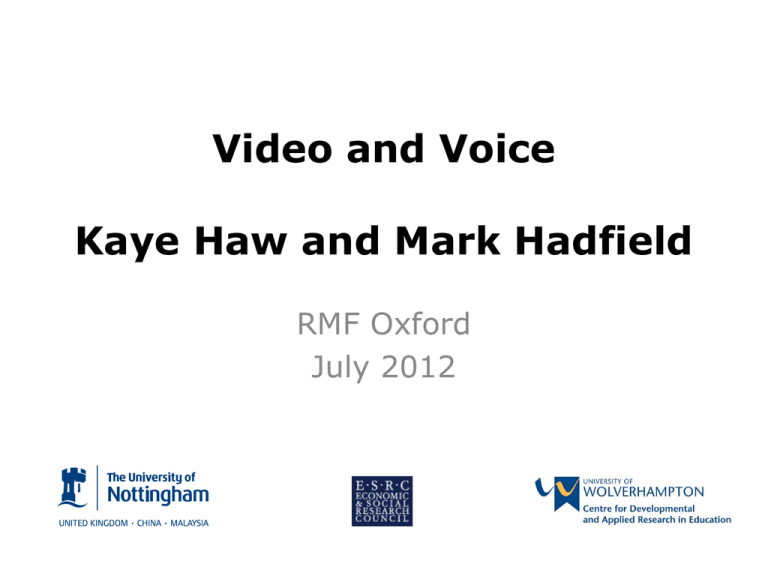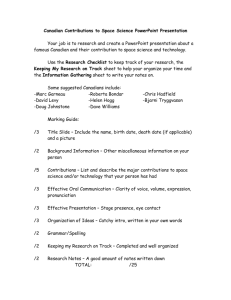Video and Voice Kaye Haw and Mark Hadfield
advertisement

Video and Voice Kaye Haw and Mark Hadfield RMF Oxford July 2012 Video and voice • Video as medium is both a product and a process. • Different video methods/methodologies are both a medium and a mode. • Voice is essentially multi-modal. Video modalities • Modalities are the abstract, non-material resources of meaning making. Media, on the other hand, are the specific material forms in which modes are realized. • Video methods and artefacts are the medium, video modalities are the abstract purposes, including meaning-making, to which these are put within research. Traditional uses of video in research • Straight data collection. • Stimulating reflection and dialogue within the research process. • A means of giving people a chance to voice their views. • Dissemination. • As an aid to participatory research. Five Basic Video Modalities 1. Extraction - using video to record a specific interaction so that it can be studied in more depth by the researcher. 2. Reflection – video supports participants to reflect on their actions, understandings and constructions of specific situations. 3. Projection and provocation – video provokes participants to critically examine and challenge norms, traditions, and power structures. Five Basic Video Modalities 4. Participation- the use of video to engage participants in a research project in ways that allows them to shape its focus and outcomes. 5. Articulation – video used to help participants voice their opinions and communicate. Five Root Metaphors 1. Extraction Sports replay 2. Reflection Mirror 3. Projection and provocation Conceptual art 4. Participation Hosting a party 5. Articulation Pop record The Crane Project: ‘Seen but not Heard’ • A group of young people expressing their experiences of being excluded from school. • Two modalities participation and provocation. • Combining video production and a product to be shown back into their school. Provocation in three parts • Articulation - video provides reflexive space by being removed from immediacy. • Representation - de-stabilisation by creating space for playfulness and irony. • Reaction - can provide a context with an obligation to listen, and a persistence which makes it more difficult to dismiss. Perceptions and Experiences of Full Body Searching • Researching prisoners and prison officers experiences and perceptions of fully body searches. • Two modalities projection and reflection. • Video product developed to encourage involvement in focus groups. Projection in three parts • Articulation - disembodied layered voices forefront the everydayness of the taboo. • Representation - anonymises and problematises the taboo by juxtaposition of views. • Reaction - can provide a context where there is a choice in how react and at what level. The potential and problems of video and voice Potential - ‘Voice' is articulated in a number of forms and video allows for the use of a variety of visual means. Problem - Video consumption, particularly around aesthetic expectations, outstrips capacity for production. Potential - ‘Voice' needs to be supported by critical literacy and video can juxtapose, pose arguments in a variety of visual and verbal forms. Problem - How to balance the need to provide support and training while maintaining a sense of ‘authenticity’. The potential and problems of video and voice Potential - ‘Voice’ needs to be linked to critical reflection and video production as a collaborative, creative and technical process provides opportunities for critical dialogue. Problem - Ownership can be extremely difficult to manage at certain points in the process. Potential - 'Voice' is premised on an audience and video can be used with range, at different times and places. It can ‘stand alone’ or be used in combination of other inputs. Problem - Peoples’ experience of video is mainly expressive rather than persuasive. It requires a strong sense of audience about who is watching, what is persuasive, and who can be influenced. References Haw, K. and Hadfield, M. (2011) Video in Social Science Research; Functions and Forms: Routledge London and New York Hadfield, M. and Haw, K. (Forthcoming) ‘Video: Methods, Modalities and Methodologies’ International Journal of research and Method in Education See Also: www.videoandvoice.co.uk Email: Kaye.haw@nottingham.ac.uk Mark.hadfield@wlv.ac.uk











